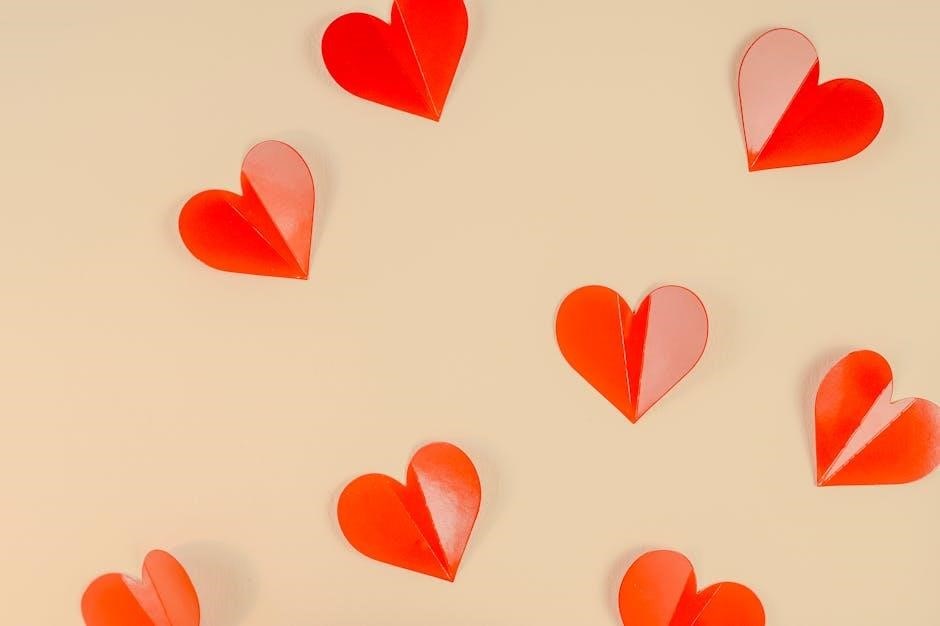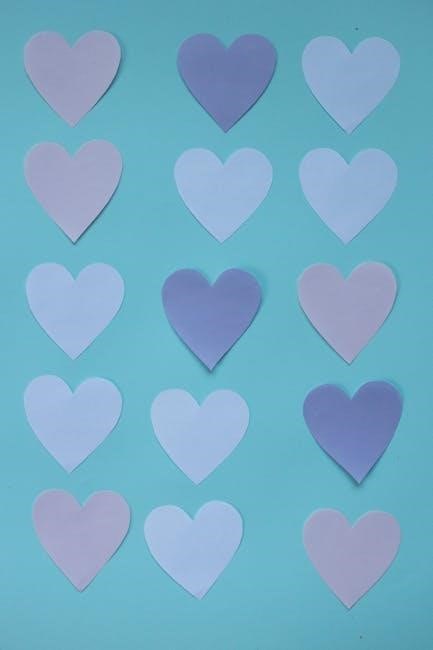Origami hearts are a beloved traditional Japanese craft, symbolizing love and creativity. They make perfect gifts or decorations, with step-by-step guides available online for all skill levels.
1.1. What is Origami?
Origami is the traditional Japanese art of paper folding, transforming simple sheets into intricate designs. It emphasizes precision and creativity, often used to create symbolic shapes like hearts. Origami fosters patience and skill, offering a meditative experience. While commonly associated with hearts, origami encompasses a wide range of designs. From basic shapes to complex models, origami appeals to all ages. Origami has become a global art form, blending tradition with modern creativity and inspiration.
1.2. The Popularity of Origami Hearts
Origami hearts have gained immense popularity worldwide for their simplicity and sentimental value. They are often used as gifts, decorations, or symbols of love, especially around Valentine’s Day. The accessibility of step-by-step guides and PDF tutorials has made it easy for people of all skill levels to create these charming designs, further boosting their appeal and cultural significance.
Materials Needed
A square sheet of paper, preferably with one colored side, is essential. A 15cm kami paper works well. Basic tools like scissors or a bone folder are optional.
2.1. Overview of Required Materials
To create an origami heart, you’ll need a square sheet of paper, ideally 15cm in size. A paper with one colored side is recommended for visibility. Optional tools include scissors for cutting or a bone folder for sharp creases. No glue or additional materials are necessary, making it an accessible craft for all skill levels.
2.2. Choosing the Right Paper
Selecting the right paper is essential for creating a perfect origami heart. Use square kami or washi paper for traditional results. Printer paper works well for beginners, while colored or patterned paper adds visual appeal. Opt for paper with one colored side to easily follow instructions. Avoid thick or textured paper, as it may not fold smoothly. Ensure the paper is square for accurate heart formation.
2;3. Tools and Additional Supplies
Besides paper, you’ll need a few basic tools: scissors for cutting, a ruler for measuring, and a bone folder or similar tool for creating sharp creases. Optional supplies include a pencil for marking folds and a flat surface for workspace. A PDF guide or printed instructions can also be helpful. Store your finished hearts in protective envelopes or boxes to keep them safe.
Step-by-Step Folding Instructions
Begin with a square paper, fold it diagonally to create a triangle, then unfold to form a crease. Next, fold the top edges to the center line and tuck the bottom corners under to shape the heart.
3.1. Starting the Base
Begin with a square piece of paper, colored side down. Fold it in half diagonally to create a crease, then unfold it. This crease will guide your folds. Fold the paper in half again in the opposite direction to reinforce the crease. Ensure all edges align neatly to maintain symmetry. Sharp creases are essential for forming the heart shape accurately.
3.2. Creating the Heart Shape
Fold the top edges of the paper to the center line, forming the sides of the heart. Fold the bottom corners up to meet the center, creating the base. Fold the top layer down, tucking it under to shape the heart. Adjust layers neatly, ensuring sharp creases for a precise form. This step defines the heart’s symmetry. Refer to the PDF guide for visual clarity.
3.3. Final Adjustments
Adjust the layers to ensure symmetry, gently pulling edges to align. Smooth any uneven creases and flatten the heart. Tuck any excess paper under the folds for a polished look. Double-check the shape and make minor tweaks for evenness. Practice makes perfect—small adjustments can refine the heart’s appearance. Refer to the PDF guide for precise visual cues to achieve a professional finish.

Tips for Perfecting the Origami Heart
- Emphasize precision and patience while folding.
- Use high-quality paper for crisp creases.
- Follow PDF guides for clear step-by-step visuals.
- Gently smooth creases to avoid tears.
- Adjust layers evenly for a symmetrical heart.
- Refer to tutorials for troubleshooting common issues.
4.1. Folding Techniques
To master origami hearts, focus on precise folding techniques. Start by making sharp creases with your fingernail or a tool. Fold edges toward the center line for symmetry. Ensure diagonal folds align corners accurately. Gently lift and tuck layers without forcing the paper. Use guides or tutorials for visual cues. Patience and practice will refine your skills, leading to a perfect heart shape.
4.2. Paper Selection Tips
Choose square paper for origami hearts, as it ensures even folds. Opt for thin, high-quality kami or chiyogami for crisp results. Select colored or patterned paper for vibrant hearts. Avoid thick or textured paper, as it may resist folding. Ensure the paper’s colored side faces up for a visually appealing finish. Proper paper selection enhances both the process and final appearance of your origami heart.

Common Mistakes and Troubleshooting
Common mistakes include uneven creases and misalignment. Troubleshooting involves adjusting folds carefully and ensuring proper paper orientation. Patience and precision are key to achieving a perfect origami heart.
5.1. Identifying Common Errors
Common errors include uneven creases, misaligned folds, and improper paper orientation. Ensure the square paper is correctly aligned and folded symmetrically. Check each step carefully to avoid mismatches in the heart shape. Using the right paper size and type is crucial. Refer to guides or videos if folds appear uneven or misshapen.
5.2. Adjustments for a Perfect Heart
To achieve a perfect heart, ensure creases are sharp and folds are precise. Adjust symmetry by aligning edges carefully. If the heart appears uneven, gently flip the model and tuck edges. Use the correct paper size and type for best results. Refold or adjust corners as needed for a balanced shape.

Variations and Advanced Designs
Elevate your origami skills with 3D heart designs and decorative embellishments. Add beads or intricate folds for unique variations, creating stunning pieces for gifts or displays.
6.1. 3D Origami Heart
A 3D origami heart adds depth and dimension to the traditional design. By layering folded sections and adjusting angles, you create a lifelike heart shape. Follow detailed PDF guides to master this advanced technique, ensuring precise folds for a polished look. This design is perfect for gifts or decorative displays, showcasing your skill and creativity.
6.2. Incorporating Beads or Decorations
Add a personal touch to your origami heart by incorporating beads, sequins, or other decorations. Attach beads to the center or edges for a elegant look, or use glue to secure decorations like stickers or gems. This enhances the heart’s visual appeal, making it a unique gift or decorative piece. DIY tutorials often include tips for seamlessly integrating embellishments.

Downloadable PDF Guides and Resources
Find comprehensive PDF guides with detailed step-by-step instructions for crafting origami hearts. These resources often include printable templates, video tutorials, and tips for perfecting your design easily.
7.1. Where to Find PDF Instructions
Downloadable PDF guides for origami hearts are widely available online. Popular platforms like Pinterest, Etsy, and specialized craft websites offer free and premium templates. Many blogs and origami communities provide step-by-step instructions in PDF format, often with accompanying images or video tutorials. Simply search for “origami heart instructions PDF” to find and download these resources directly to your device.
7.2. Printable Templates and Tutorials
Printable templates and tutorials for origami hearts are readily available online, offering step-by-step guides with detailed instructions and visuals. Many websites provide downloadable PDFs with customizable designs, catering to both beginners and advanced folders. Video tutorials and interactive guides further enhance the learning experience, ensuring everyone can master the art of creating beautiful origami hearts with ease and precision.

Uses for Origami Hearts
Origami hearts are versatile, used as Valentine’s Day gifts, card decorations, or heartfelt tokens. They also serve as charming home decorations, adding a touch of handmade elegance to any space.
8.1. Gift Ideas
Origami hearts make thoughtful gifts, especially for Valentine’s Day or anniversaries. They can be used to decorate cards or as standalone tokens of affection. Tuck a heartfelt message inside or attach beads for a personalized touch. These delicate creations are perfect for expressing love and care, offering a unique and handmade alternative to traditional gifts.
8.2. Decorative Purposes
Origami hearts are versatile decorations, perfect for adorning cards, gift boxes, or wall displays. They add a delicate, handmade touch to any setting, making them ideal for Valentine’s Day or romantic occasions. Multiple hearts can be arranged to create beautiful garlands or centerpieces, spreading love and warmth in your home or event space.
For a personalized touch, combine origami hearts with ribbons, beads, or flowers to enhance their visual appeal. Their intricate design makes them a charming addition to scrapbooks, photo frames, or even wedding decorations, offering a thoughtful and artistic way to celebrate love and connection.

The Cultural Significance of Origami Hearts
Origami hearts embody Japanese tradition, symbolizing love and kindness. They reflect the art of paper folding, deeply rooted in Japanese culture, representing heartfelt emotions and thoughtful gestures.
9.1. Origins in Japanese Culture
Origami hearts trace their roots to ancient Japan, where paper folding symbolized artistry and spirituality. The heart design, while modern, draws inspiration from traditional origami motifs, expressing emotions like love and respect. These creations resonate with cultural values, making them meaningful symbols in both traditional and contemporary contexts.
9.2. Symbolism of the Heart Design
The origami heart symbolizes love, kindness, and unity, often used as a token of affection or appreciation. Its delicate design represents the fragility and beauty of emotions, making it a popular choice for gifts, decorations, and heartfelt messages. The heart’s universal appeal transcends cultures, embodying warmth and connection in its intricate folds.
Creating an origami heart brings joy and satisfaction. Its simplicity and versatility make it a delightful craft for all skill levels. Give it a try!
10.1. Final Thoughts
Creating an origami heart is a simple yet meaningful craft that brings joy and satisfaction. With clear instructions, anyone can master this traditional design, perfect for gifting or decorating. The process fosters patience and creativity, making it a delightful activity for all ages. Give it a try and enjoy the heartfelt results!
10.2. Encouragement to Try
Origami hearts are a delightful craft that combines creativity with mindfulness. Whether you’re a beginner or seasoned folder, the process is rewarding and fun. Don’t hesitate to give it a try—each fold brings you closer to a beautiful, heartfelt creation. Embrace the journey, enjoy the process, and share the joy of origami with others!